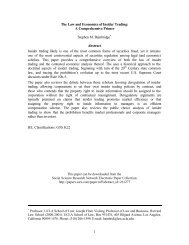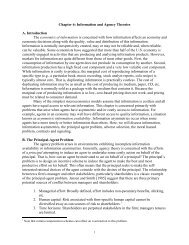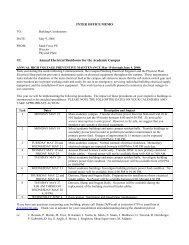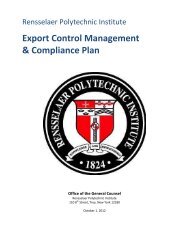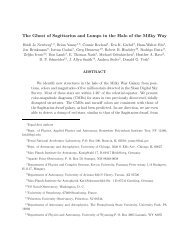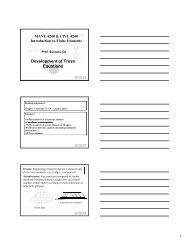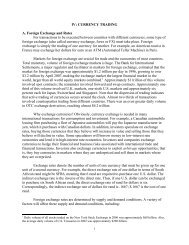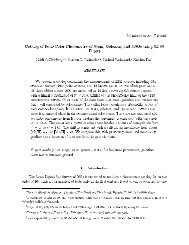Quiet Crisis - Building Engineering and Science Talent
Quiet Crisis - Building Engineering and Science Talent
Quiet Crisis - Building Engineering and Science Talent
You also want an ePaper? Increase the reach of your titles
YUMPU automatically turns print PDFs into web optimized ePapers that Google loves.
The nation needs to know what’s really working in elementary <strong>and</strong><br />
high school mathematics, freshman physics <strong>and</strong> chemistry, graduate<br />
schools <strong>and</strong> corporate R&D teams to develop – <strong>and</strong> draw upon – the<br />
talent of under-represented groups.<br />
Priorities for the Federal Government<br />
Congress <strong>and</strong> the executive branch must lead on the issue of<br />
under-representation. This will involve giving voice to the<br />
national need – <strong>and</strong> backing that voice with direction <strong>and</strong><br />
resources. Four priorities st<strong>and</strong> out:<br />
Maximize the Value of Current Programs The National<br />
<strong>Science</strong> Foundation, Department of Education, Department of<br />
Defense, Department of Energy, NASA <strong>and</strong> other agencies have<br />
longst<strong>and</strong>ing records of commitment to under-represented<br />
groups. But federal resources are scattered <strong>and</strong> would have<br />
greater impact if they were more closely aligned. An interagency<br />
initiative to insure such alignment would enhance both<br />
the effectiveness <strong>and</strong> credibility of federal investment.<br />
Other national programs, such as the National Teachers Corps<br />
which recruits up to 75,000 qualified teachers annually to serve<br />
in high-need schools, should be exp<strong>and</strong>ed <strong>and</strong> strengthened<br />
with such measures as including subsidies for the acquisition<br />
of teaching credentials.<br />
Consider a Bold Federal Initiative While such programs are<br />
important, it may be even more worthwhile to consider a bold<br />
initiative similar to the National Defense Education Act of 1958,<br />
when Congress found “that an educational emergency exists<br />
<strong>and</strong> requires action by the federal government.” 15<br />
Leverage Federal Dollars Federal investments to develop a<br />
stronger, more diverse talent pool should not st<strong>and</strong> alone, but<br />
should be matched by states <strong>and</strong> local communities. The 25<br />
states in which minorities make up at least 25 percent of the<br />
pre-K through 12 student population deserve priority attention.<br />
Increase Investment Congress <strong>and</strong> the executive branch cannot<br />
just re-divide the pie, but must allocate fresh resources to<br />
exp<strong>and</strong> educational opportunities in mathematics <strong>and</strong> science<br />
for under-represented groups. Important new initiatives, such<br />
as NSF’s five-year $1 billion Mathematics <strong>and</strong> <strong>Science</strong><br />
Partnerships, should represent net increases in investment.<br />
Programs that have a track record of proven value should be<br />
exp<strong>and</strong>ed. New investments that promise to make a real difference,<br />
such as Pell-like financial aid grants for underrepresented<br />
students in science <strong>and</strong> engineering majors,<br />
deserve serious consideration.<br />
Priorities for Education<br />
Research universities have a special leadership responsibility.<br />
Not only are they strategically positioned between pre-K<br />
through 12 <strong>and</strong> the workplace, but they will educate the<br />
successor generation of American scientists <strong>and</strong> engineers.<br />
The list of “must-do’s” for research universities should include:<br />
Strengthen the University Presence in Pre-K Through 12<br />
Mathematics <strong>and</strong> <strong>Science</strong> Education The crown jewels of the<br />
nation’s educational institutions must engage far more intensively<br />
in the feeder system. One model that is producing results<br />
entails adopting students from low-income school districts<br />
from 7th through 12th grade. These students receive advanced<br />
instruction in algebra, chemistry, physics, <strong>and</strong> trigonometry, as<br />
well as mentoring <strong>and</strong> college financial planning seminars for<br />
students <strong>and</strong> their parents. Such models should be shared<br />
among research universities, adapted as needed, <strong>and</strong> scaled<br />
nationwide. At the same time, universities should develop alternatives<br />
to the traditional admissions process to ensure that the<br />
abilities of prospective students from under-represented<br />
groups are fairly <strong>and</strong> accurately assessed.<br />
Nurture the Undergraduate <strong>and</strong> Graduate Education of Under-<br />
Represented Groups Slowing the attrition of women, African<br />
Americans, Hispanics, Native Americans, <strong>and</strong> students with<br />
disabilities will have the greatest immediate impact on the science<br />
<strong>and</strong> engineering talent pool. The causes of such attrition<br />
are understood <strong>and</strong> models exist for mitigating such attrition.<br />
The problem must be addressed by the presidents, deans,<br />
department chairs <strong>and</strong> tenured faculty who have the authority<br />
to change the learning environment.<br />
Exp<strong>and</strong> Faculty Diversity One of the greatest barriers to<br />
increasing the production of under-represented groups is the<br />
absence of role models — both in teaching <strong>and</strong> in research.<br />
Leaders of the nation’s research institutions must commit<br />
jointly to transform the composition of their junior <strong>and</strong> tenured<br />
faculties.<br />
Priorities for Industry<br />
Internationally competitive companies are the U.S. economy’s<br />
greatest assets, but many also face high-stakes choices<br />
between going global or strengthening both their R&D <strong>and</strong> production<br />
bases at home. The commitment of these companies<br />
to develop <strong>and</strong> utilize more homegrown science <strong>and</strong> engineering<br />
talent is indispensable. Their agendas should include:<br />
Strengthen the Corporate Presence in Pre-K Through 12<br />
Mathematics <strong>and</strong> <strong>Science</strong> Education Although some of the<br />
nation’s most prominent corporate leaders have set leadership<br />
examples, industry’s commitment must become a norm across<br />
the board. The professional development of mathematics <strong>and</strong><br />
science teachers in middle school <strong>and</strong> high school is a logical<br />
15<br />
National Defense Education Act of 1958, Title I.<br />
7



